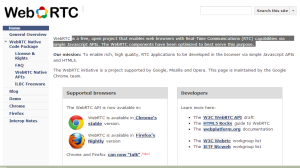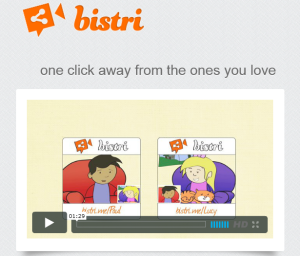Posted on Enterprise Tech Central
Web Real Time Communications (WebRTC) is a development plan originally owned by Google that has been transformed into a free open project (http://www.webrtc.org/) to enable rich, high quality Real-Time Communications (RTC) capabilities for compliantweb browsers via simple JavaScript APIs and HTML5.
With WebRTC, developers are able to addreal-time communication with a few simple API calls in their JavaScript using a browser (Chrome or Firefox) that have all this built in.
This infers that there is already a coverage for a large part of the existing market and the number of potential users will increase with the integration of WebRTC in Internet Explorer (something that should be seen in 2013).
Existing UC solutions for desktops and mobile devices require applications and/or browser plugins. WebRTC offers the promise of a pre-installed feature installed in every desktop and mobile browser.
The demonstrations seen up to this moment (http://www.webrtc.org/demo ) are really impressive, with different operating systems and browsers talking to each other in a really smooth manner.
The capability to create a call or a meeting with no need for a plug-in or an app would be really interesting, resolving common issues such as incompatibilities due to the operating systems and devices fragmentation or the risk of malware slipstreamed in the apps.
During this year a couple of solutions based on WebRTC (Bistri and Twelephone) have been released.
Bistri (https://bistri.com/) allows one to connect with Facebook, Google, Windows Live, Yahoo and others unifying our “presence” (the indicator of our state and of our willingness and capability to communicate) and enabling the use of chat, audio and video calls from inside a web browser.
Twelephone (http://twelephone.com/) integrates with Twitter as a base platform for identity and messaging, offering the high quality audio and video features of WebRTC.
It is interesting to say that the WebRTC specifications include a capability to transmit data that is not limited to audio and video streams, crating the basics for further and different usages
On the bad side, WebRTC is in its infancy, and there are potential issues especially regarding the interoperability if there will be no agreement on the standards to use.
For example the Microsoft proposal (CU-WebRTC), is a bit different from the ones included in Chrome and Firefox. One of the characteristics of CU-WebRTC is that it would leave it up to the developer to settle on a codec for video and other specifics.
From a technical point of view, there are a number of complex aspects, so that establishing a connection between two users or creating the required communication channels requires a non-trivial effort.
As a consequence of the availability of the requirements in Chrome, Google’s implementation is at the moment the base around which WebRTC is growing but ifMicrosoft and Apple will support different visions, the common denominator will get lost.
If the vendors will develop their own versions of WebRTC the most important aspect of the solution (ubiquity) will be lost.
The quality that WebRTC will be able to grant and the reception that such a pervasive technology will have from the public are important parameters that will condition the adoption of this technology in the future.




